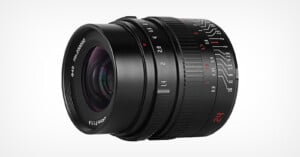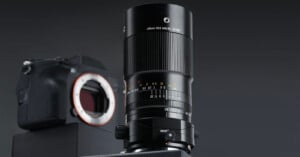
Sigma’s New 500mm f/5.6 Lens is So Popular, It Can’t Keep Up With Orders
Sigma's latest compact telephoto optic, the 500mm f/5.6 DG DN OS Sports lens is so popular that the company can't keep up with pre-orders.

Sigma's latest compact telephoto optic, the 500mm f/5.6 DG DN OS Sports lens is so popular that the company can't keep up with pre-orders.

It’s not often that I get to review a lens that the world has never seen before. I’ve reviewed plenty of f/1.4 lenses and I’ve reviewed the occasional 15mm fisheye, but a 15mm diagonal fisheye with an f/1.4 maximum aperture is a first for me.

Reports out of China suggest that Viltrox is preparing to launch four new prime lenses, including its first LAB series prime lens, a new product line that promises pro-level image quality.

Meike will release a new full-frame 50mm f/1.8 autofocus lens for Sony E and Nikon Z next month for a very reasonable $160.

Canon doesn't currently like anyone making autofocus-equipped lenses for its RF mount, but Yongnyo keeps doing it. The latest is a 35mm f/2 lens that is finding its way onto store shelves internationally.

Zhongyi Optic's latest lens is the Chuichi Kogaku Speedmaster 20mm f/0.95, an ultra-fast, manual focus, mirrorless lens designed for Nikon, Canon, Sony, and Fujifilm APS-C cameras that suspiciously shares a lot in common with its 20mm T1.0 Mitakon lens.

Yongnuo has announced the YN 50mm f/1.8 Z DA DSM prime lens for APS-C Nikon Z mirrorless cameras.

Friday, Cosina announced the Voigtlander Nokton 40mm f/1.2 Aspherical lens for Canon RF mount. Coming in January, it will be the second lens it has produced for the mirrorless mount and only the second third-party lens officially authorized by Canon.

Chinese company TTArtisan announced a couple of new APS-C prime lenses in China, including an AF 56mm f/1.8 lens for E, X, and Z mount cameras and a limited-edition yellow AF 27mm f/2.8 lens for Fujifilm X Series cameras.

We are proud to announce the results of the third-annual PetaPixel Awards where we give honors to a small list of the best new photography products released in the last year as voted by the PetaPixel staff.

Meike's promised 85mm f/1.4 autofocus lens that it announced in April is finally shipping for a very reasonable $470. But the promised RF support is, as most probably predicted, probably not coming.

I consider myself an ardent supporter of Ricoh/Pentax products and have always endeavored to review its cameras and lenses when many others have chosen not to. I also think that the Pentax brand has really found its niche as more of a boutique manufacturer, focusing on the classic SLR design -- a move that I think makes a ton of sense in today's waning market.

Leica added two wide-angle lenses to its L-mount portfolio this morning: the Super-Vario-Elmarit-SL 14-24mm f/2.8 ASPH and the Super-APO-Summicron-SL 21mm f/2 ASPH.

7Artisans announced a new 9mm f/5.6 full-frame ultra-wide prime lens for the most popular mirrorless mounts that promises a relatively close focusing distance and a 132-degree viewing angle.

It's rare to see Canon and Nikon release lenses at exactly the same time, but it's downright unheard of to see both lenses be one-of-a-kind. That's exactly what happened this week, and the PetaPixel Podcast team shares their thoughts.

Nikon announced the new 600mm f/6.3 VR S super-telephoto prime lens that it says is the lightest 600mm prime in its class, enabling handheld shooting at extreme distances for Nikon Z photographers.

Thypoch is a brand new manual lens manufacturer that is debuting with the Simera 35mm and 28mm f/1.4 prime lenses for Leica M-mount.

Viltrox appears as though it strongly wants professional photographers to take its optics seriously, as it plans to release three more fast prime lenses before the end of the year.

We've seen the 100-400mm f/5-6.3 DG DN OS Contemporary before because it's the current full-frame super-telephoto option from Sigma for mirrorless cameras. What we haven't seen before is a full-frame Sigma that has been specifically adapted for the APS-C-sized Fujifilm lens mount -- until now.

Sigma has announced that it is bringing the 100-400mm f/5-6.3 DG DN OS and 23mm f/1.4 DC DN Contemporary lenses to Fujifilm X-mount, bringing the total number of Sigma optics for the format to six.

Meyer Optik Görlitz has announced that the Biotar 75mm f/1.5 II is now available. This is a new edition of what the company says was a world-famous lens that delivered one of "the most sought-after bokeh" in the world.

Hasselblad has announced the XCD 4/28P lens, a 28mm f/4 medium format lens that has an equivalent 35mm focal length of 22mm and is designed for use on the company's X System cameras.

The Viltrox 27mm f/1.2 Pro Autofocus lens for Fujifilm X-mount is now available. Touted as a "masterpiece of optical engineering," it is also remarkably affordable at $545.

Viltrox stepped up to the plate last year and delivered its first pro-level lens in the form of the AF 75mm f/1.2, which is a devastatingly good lens. It has followed that with the 27mm f/1.2 that has a tempting price of just $545.

Cosina will release a new Voigtlander Nokton 50mm f/1.2 lens made exclusively for Fujifilm X-mount this September.

TTArtisan has announced a new 100mm f/2.8 lens for M42 mount that instead of correcting what is normally described as a defect, embraces it: soap bubble bokeh.

Viltrox has released the 75mm f/1.2 lens it originally launched for Fujifilm X-Mount in both Nikon Z and Sony E mount variants.

Sigma has been celebrating its 10th year in the Chinese market this July and is capping the festivities with a 35mm f/1.4 DG DN Classic that has the same optical construction as the original lens but without coated elements, which emphasizes flare and lightens contrast.

In August, Cosina will release a new Voigtlander-branded Color-Skopar 28mm f/2.8 Aspherical for VM mount (compatible with Leica M mount) in two types as well as another version in L39 mount.

The previously rumored Zhong Yi Optics (ZY Optics) APO 200mm f/4 Macro 1X Lens is official and available now for a wide range of lens mounts, including Sony E, Nikon Z, Canon RF, Leica L, and Fujifilm X.

Venus Optics had a big hit with the original Laowa 24mm f/14 probe lens. What first garnered snickers and jokes, proved to be a unique video lens and the peri-probe lens with a 90-degree rotating end soon followed. Now Laowa has some serious competition from a company with a name I struggle to pronounce.

Sigma has announced the "world's widest" f/1.4 prime lens: the 14mm f/1.4 DG DN Art. The company says this new optic was born from our engineers' passion for capturing the widest, brightest, highest-resolution, and most captivating starry sky images possible.

7Artisans has announced a new 24mm f/1.4 wide-angle prime lens for six APS-C camera mounts that is extremely cheap, but it doesn't have autofocus.

Nikon has announced the Nikkor DX 24mm f/1.7 lens, a fast aperture, compact prime for its Z-mount APS-C cameras that promises to bring bokeh to the DX format for $280.

Following up on its 28mm f/13 macro probe lens from 2022, AstrHori has announced a new 18mm f/8 2x Macro Probe Lens designed for APS-C cameras and available in Sony E, Nikon Z, Fujifilm X, Canon RF, Canon EF, and Micro Four Thirds.

Ricoh has announced two new 50mm f/1.4 lenses that look very similar on the outside but are designed to produce distinctively different image renditions.

TTArtisan has announced a full-frame 100mm f/2.8 tilt-shift 2x ultra macro lens for Sony E, Fujifilm X, Canon RF, and Nikon Z mounts.

When I reviewed the Laowa Argus 35mm f/0.95 I was struck by how bad it was, but also how good it could be. Normally, I rate a lens based on how well it handles flare, how sharp it is, and how well it controls chromatic aberrations. Going by the above criteria, the Argus should have failed spectacularly.

Meike has announced a new 85mm f/1.4 autofocus lens for Sony E, Nikon Z, Leica L, and -- surprisingly -- Canon RF mounts. If this stands, Meike will be the first third-party manufacturer to come to market with an autofocus-equipped lens for Canon's mirrorless mount.

The Vertigo Lens Turret is an adapter that fits onto a camera's lens mount and allows a filmmaker to effortlessly switch among three different attached lenses, a design that is set to "get the cinema world spinning."